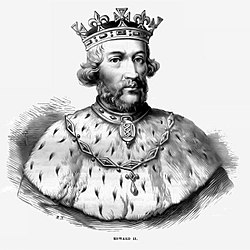热门问题
时间线
聊天
视角
愛德華二世
来自维基百科,自由的百科全书
Remove ads
愛德華二世(英語:Edward II,1284年4月25日—1327年9月21日),登基前也被稱作卡那封的愛德華,金雀花王朝英格蘭國王。他的一生皆為其寵信的佞臣和發起叛亂的王公貴族所主宰,以致於最終悲慘地死去。葬於格洛斯特主教座堂。


Remove ads
出身背景
愛德華二世是英格蘭國王、愛爾蘭領主以及法國西南部加斯科涅的統治者(他是法國國王的封建附庸)愛德華一世[1]和法國北部蓬蒂厄女伯爵埃莉諾的第四個兒子[2]。埃莉諾來自卡斯蒂利亞王室。愛德華一世被證明是一位成功的軍事領袖,在1260年代領導鎮壓男爵起義,並參加了第九次十字軍東征[3]。在1280年代,他征服了北威爾士,將威爾士本土王子逐出了政權,並在1290年代干預了蘇格蘭內戰,聲稱對該國擁有宗主權[4]。愛德華一世被同時代的人認為是一位非常成功的統治者,在很大程度上能夠控制構成英國貴族高層的強大伯爵[5]。歷史學家邁克爾·普雷斯特維奇(Michael Prestwich)將愛德華一世描述為「激發恐懼和尊重的國王」,而約翰·吉林厄姆則將他描述為「高效的惡霸」[6]。
生平
愛德華二世於1284年4月25日出生於北威爾士的卡納溫城堡,距離愛德華一世征服該地區不到一年,因此有時被稱為卡納溫的愛德華[7]。15歲時,因為與法國議和使其交還加斯科涅的領地,而與法國國王美男子腓力四世之女法蘭西的伊莎貝拉結婚;並在1301年的林肯會議中被封為威爾斯親王,該年4月他前往領地得到威爾斯人和邊境領主的效忠。他曾在1306年,征討羅伯特一世所率領的蘇格蘭叛軍而立下戰功;卻在隔年,被其父「發現長子對某一位加斯科涅騎士的喜愛沒有節制」而陷入爭吵,這位騎士叫皮爾斯·加韋斯頓,愛德華不顧他出身卑微而準備提升其爵位,這正是其父大怒之故。其父過世、葬禮尚未舉行之際,他就迫不及待地把加韋斯頓擢升為康沃爾伯爵。[8]1309年,以愛德華一世的侄子蘭開斯特伯爵托馬斯為首,貴族們結成同盟反對國王。1310年,該貴族集團成功迫使愛德華二世成立一個改革委員會。委員會擬出一套限制國王權力的條例,並為英格蘭議會所通過。在貴族的強烈要求下,愛德華二世把加韋斯頓逐出國外,但後來又偷偷接回;結果加韋斯頓在1312年6月被憤怒的貴族們處死。
愛德華二世於1313年力勸教皇克勉五世任命其寵臣伍斯特主教沃爾特·雷諾茲為坎特伯雷大主教。但後來他又與雷諾茲關係決裂。
1314年,愛德華二世率領一支龐大的軍隊討伐蘇格蘭國王羅伯特一世,企圖再度將北方鄰國置於英格蘭統治之下。然而在班諾克本之戰中,英格蘭大軍被蘇格蘭人打得人仰馬翻。為了交換被俘的貴族,愛德華二世放回了羅伯特已被囚禁8年的王后伊麗莎白·伯格、妹妹克里斯蒂娜、瑪麗、女兒馬喬麗。愛德華二世名聲受損,從此更加受到貴族擺布。到1315年,蘭卡斯特的托馬斯已是大權在握。該年英格蘭竟至面臨蘇格蘭入侵的危險:羅伯特一世帶兵進入英格蘭境內,並派其弟愛德華·布魯斯征服英格蘭屬地愛爾蘭。1316年,愛德華·布魯斯已宣布為愛爾蘭國王。
此時愛德華二世又有了兩個新的寵臣:德斯彭瑟父子,他為他們分封土地的做法受到貴族們的激烈反對。1321年,議會宣布放逐德斯彭瑟父子,而愛德華以武力支持德斯彭瑟。蘭卡斯特的托馬斯領導貴族發動叛亂,結果被愛德華二世打敗並遭處決(1322年)。愛德華二世因這次軍事成功擺脫了貴族長期的控制。1323年,愛德華承認羅伯特一世為獨立的蘇格蘭王國的國王,從而實現了兩國的和平。
德斯彭瑟父子的飛揚跋扈引起愛德華二世的王后伊莎貝拉不滿。1325年伊莎貝拉回法國安排兒子的婚事,在那裡她成為一個因反對德斯彭瑟而被愛德華二世放逐的青年貴族羅傑·莫蒂默的情婦。1326年,伊莎貝拉與莫蒂默率領流亡貴族入侵英格蘭。他們的活動受到了伊莎貝拉的哥哥法國國王查理四世的支持。入侵者與愛德華二世的國內反對者取得了勝利,他們將德斯彭瑟父子處決。
1327年,議會廢黜了愛德華二世。愛德華被迫退位,被放逐到南威爾士。同年,他在巴克利城堡中遇害。按照傳說,愛德華二世被人從肛門插入燒紅的撥火棍,死得極其悲慘[9]。多數的歷史學家不採信這個說法,懷疑劫持者不太可能會用如此容易遭到察覺的手法來謀殺[10]。查爾斯·狄更斯認為是被逼吞燒紅的烙鐵而死。愛德華二世年幼的兒子愛德華三世繼承了王位。
Remove ads
家庭
Remove ads
王后:法蘭西的伊莎貝拉(c.1295-1358)
後世
克里斯托弗·馬洛曾於十六世紀以愛德華二世為藍本,寫了一套名為《愛德華二世》的話劇,而此劇則於1991年被戴力·渣文改編成同名電影。
參考文獻
書目
外部連結
Wikiwand - on
Seamless Wikipedia browsing. On steroids.
Remove ads

